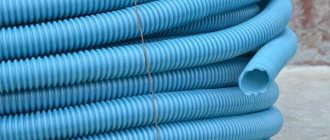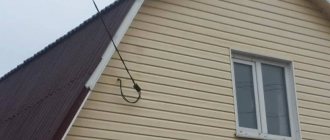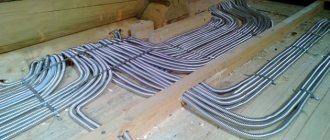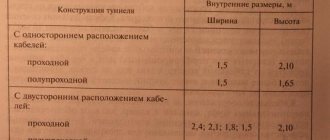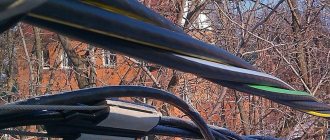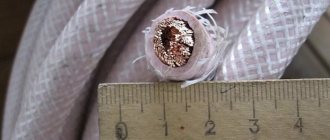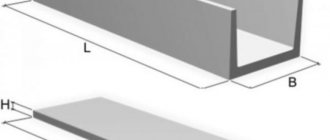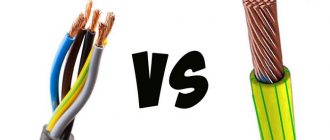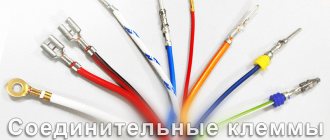When carrying out electrical installation work, it is often necessary to lay electrical wiring in an open way. To ensure protection of the electrical cable from mechanical influences, precipitation and other factors, to make a neat and aesthetic installation of power or low-current networks, a corrugated tube or, as it is also called, corrugation is used.
Why do you need corrugation?
Laying electrical cables and wires in corrugated areas is recommended for various reasons:
- When laid in flammable walls (wooden or frame), behind flammable finishing (lining, PVC boards), when attached to wooden floors - for fire safety reasons. In this case, non-combustible shells are chosen.
- When laying behind finishing materials - behind lining, plasterboard, PVC boards, etc. - for security reasons. To make it more difficult to damage the cable when trying to hang something on the wall. In this case, the most important indicator is the hardness of the shell. Corrugated pipes for electrical wiring come in different colors. It's for a reason, colors have meaning.
- When laying cables in a screed or under the floor, under finishing, corrugation is used for several purposes. Firstly, to protect against compression when pouring concrete. Secondly, to be able to change the cable if it is damaged without destroying the floor. Third, to protect against damage.
- When laying externally, the sheath is needed to protect the cable from atmospheric influences (ultraviolet) and mechanical damage. When laying open through the air, a corrugation with a wide temperature range (to withstand heat and frost) and durability are required. to ultraviolet. If the cable is suspended, reinforcement is also necessary to increase the load-bearing capacity.
- When laying underground, water resistance as well as rigidity are important. When laying rigid corrugation on turns, it is better to use special couplings
In general, corrugation, even metal, is not the best protection against mechanical destruction. You can only hope that if you feel that the drill has failed, you will be able to stop in time. And in order to definitely not get into the electrical wiring, it is better to have an exact plan for its installation with measurements and reference to the corners. After all, not every wiring detector detects a corrugated cable, even under load. So, before pouring the screed, before finishing, don’t forget to take photographs, sketches and mark distances.
Stylist tips
Among the numerous recommendations from stylists on choosing and creating hairstyles, we often receive advice on the care and restoration of hair after a particular procedure. The impact of high temperatures on the hair structure during crimping also has its consequences. Care procedures after such hairstyles are not complicated. If you use a straightening iron frequently, change your regular hair wash to a special moisturizing shampoo. Herbal decoctions, natural cosmetic oils and a variety of moisturizers for split hair are also very effective in restoring hair.
Original hairstyles with corrugated elements are suitable for young ladies of any age. Fashionable waves and volume of corrugation can serve as an independent styling method or serve as a basis for subsequent variations. In any of the examples, you won’t find a better assistant in creating a stylish and fashionable hairstyle.
Types of corrugations for laying cables
Corrugated cables are available in different strengths:
- Easy. It has a thin wall and the highest degree of flexibility. Recommended for installation under cladding in walls and ceilings. Doesn't hold mechanical load well.
- Average. A little thicker than light, but not as stiff as heavy. Can be used in walls and screeds. They are good for walls, but it is better to lay heavy corrugation in the screed.
This is a double-walled corrugation - ribbed on the outside, smooth on the inside. It makes re-tightening the cable no problem. - Heavy. The walls are thick, flexibility is low. You can lay it in a screed or bury it in the ground. For turns, it is better to use angles or special couplings, since the minimum bending radius is quite large. They provide a normal degree of protection both in terms of moisture and dust resistance.
- Reinforced. Plastic sheaths are applied over twisted steel wire. This is the best option for laying in the ground and for hanging.
As you can see, the classification is based on strength properties, which determines the area of use.
Varieties
In addition to all this, there is also corrugation with and without broaching. A broach is a thin cable or wire that makes it easier to tighten the cable into the corrugation. The cable is tied to the end of the cable, pulled at the other end, tucking the cable inside. Without pulling it will be difficult to cope with this task - with sufficient rigidity, several meters of cable can simply be pushed inside, but if the route is long, this will be too difficult.
The cable corrugation can be with a broach (the correct name is “probe”) or without
If we talk about the types of plastic corrugation, we must mention that there is a two-layer corrugation. On the outside it has the same ribbed surface, but on the inside it is smooth. Corrugation for a cable of this type is expensive, but if necessary, you can actually stretch a new cable into it. In those events where the inner wall is ribbed, this is not always possible - if the track has a minimum of turns, and even those over a wide radius.
Metal and metal-polymer corrugation
Metal corrugation for cables also varies. It is made of galvanized or stainless steel. In addition, there is a metal corrugation with a polymer coating. It has the best characteristics for protection against dust and moisture. This protective shell is also called metal-polymer.
Advantages of polyethylene pipes over steel pipes
A much lower price is an important, but not the most important advantage of plastic products compared to metal ones. A polyethylene pipe for underground cables has other advantages.
- Long service life.
For reference! The minimum warranty period specified by manufacturers is 50 years. But with high-quality installation and operation under normal conditions, it can turn out to be much more.
- Easy installation, the ability to connect small cross-section pipes without welding.
- Possibility of laying routes with bends without unnecessary fittings.
Laying along a curved path Source elektroas.ru
- Light weight.
- Strength at any temperature.
- Resistant to corrosion and rotting due to moisture.
- Excellent electrical insulating properties, allowing you to do without grounding.
- Safety against short circuits - the plastic shell stops combustion.
- Environmental safety - polyethylene does not decompose in the ground and does not emit toxic substances.
What materials?
Corrugation for cables and electrical wires is made of plastic and metal. Different materials are used, with different characteristics. They must be selected based on the tasks they must perform.
- Polypropylene (PPR). The color of this corrugation is usually blue, the material is self-extinguishing and does not support combustion. It is characterized by increased water resistance and can be used for laying cables outdoors or in rooms with high humidity.
- PVC (polyvinyl chloride). The color is gray pipes, self-extinguishing. PVC corrugation is not waterproof and can only be used in dry rooms. Black cable corrugation is most often made of HDPE, but it can also be made of polypropylene (PPR)
- HDPE (low density polyethylene). Color - orange, black, the material is flammable, but resistant to chemical influences and water. Area of application: laying in screeds and grooves in non-combustible walls, open laying on the street.
- Metal (stainless or galvanized steel). Non-flammable material, resistant to mechanical and chemical influences. Recommended for electrical wiring in flammable buildings (wooden, frame). Also good for outdoor installations.
If we talk about compliance with fire safety standards when installing gaskets in flammable walls, the ideal option is a metal pipe. It saves you from loads that may arise when the size of the building changes. Rodents cannot cope with it either. This is also the best option from a fire safety point of view: even if short-circuit currents occur and the circuit breaker does not operate, the probability of burning through a pipe with a wall thickness of 2 mm is very small. This means the fire will not start. If laying electrical cables in pipes does not appeal to you at all, then you can use metal cable ducts or corrugated stainless steel or galvanized steel.
Why do you need a corrugated hose?
Installing electrical wiring is a responsible matter that does not tolerate mistakes. The safety of staying in electrified premises directly depends on its quality.
The benefits of civilization in the form of glowing light bulbs and numerous household appliances, by definition, cannot work without being connected to the power grid.
And any live electrical cable is a source of damaging current that is dangerous to humans.
It is recommended to use corrugated cables for electrical wires everywhere (for hidden and open installation methods, for installation outdoors and indoors). If this is not possible for aesthetic reasons, then it should be replaced with a decorative cable channel
The first protection against electric shock is the insulating braid of the cable itself. Regardless of the material used, it reliably protects a person from the current flowing through the veins.
However, insulation does not last long. These aluminum or copper wires can last 15–25 years, but the outer braid on them is often damaged within 3–4 years after the wiring is put into operation.
The service life of electrical wire insulation is greatly reduced due to:
- high humidity (outdoor or room);
- overheating under increased loads;
- ultraviolet radiation and other factors.
The result is a breakdown, short circuit, fire and electric shock to a person. To minimize risks, electricians lay wires in a corrugated sleeve.
On the one hand, it serves as an additional barrier between electric current and a person, and on the other hand, it serves as protection for the cable.
If the need arises to replace the old wire in the corrugation, it is simply pulled out of the sleeve, and a new one is inserted in its place - and it does not matter whether this channel is located under the finishing or in a concrete screed
A cable laid in a corrugated pipe receives protection from:
- compression and other mechanical damage;
- ultraviolet radiation and precipitation (when laying wires outdoors);
- exposure to moisture.
And the last thing is fire safety. All corrugated hoses for electrical cables are made of non-flammable or self-extinguishing materials.
This reduces the likelihood of exposure to an open flame on the wire inside the corrugation, and also prevents the spread of fire during short circuits and fires of the plastic cable braid.
Cable corrugation, sizes, prices
Corrugated pipes for electrical networks are available in sizes from 16 mm to 65 mm. When choosing a size, you need to take into account that these products have two diameters - outer and inner. If you are going to lay several conductors - wires or cables - the diameter must be selected so that there is a clearance of at least half the radius. This requirement is based on the fact that when installed in groups (it is necessary, by the way, to take a special cable), it will heat up more and the presence of an air gap will contribute to better heat dissipation.
The price of corrugated electrical pipes depends on many factors
Size selection
The choice of corrugation diameter also depends on the area where it will be laid:
- for lighting fixtures - 16 mm;
- to sockets and switches - at least 20 mm;
The size of the corrugation for the electrical cable is selected depending on the number and size of the conductors - from the main distribution box to the next box, from the shield - at least 25 mm;
- the connection between two electrical panels is at least 32 mm, and it is better to have a spare second line;
- passage through the floors with rigid corrugation of at least 40 mm in diameter;
- laying low-current cables (telephone, internet, antenna, etc.) - from 25 mm.
The diameter of the corrugation for laying the cable is selected depending on the number and cross-section of wires. Data for copper conductors are given in the table.
Table for choosing the diameter of the corrugation for cables and wires depending on the cross-section and number of wires
This information is for reference only, but you can use it as a guide. You can take a larger, but not smaller diameter.
Prices
Generally speaking, the cheapest is PVC cable corrugation, in the middle range - PP and HDPE, and the most expensive is metal corrugation. Moreover, the option with broaching is slightly more expensive than without it. When purchasing, you need to pay attention to the same wall thickness and color uniformity.
Different materials, colors, wall thicknesses and different prices
Corrugated cables are sold in coils of 50 and 100 meters, less often you can find them in meters, but the price is then a little higher. In general, the price depends not only on the material, but also on the wall thickness. The cheapest is lightweight PVC corrugated cable, but sometimes it looks more like just a film. It’s hard to say what this can protect against. If you care about quality, it is better to purchase everything related to electrical equipment not in construction supermarkets like Leroy, etc. and in specialized ones. The quality there is usually better, and the prices, if higher, are reasonable. To give you an idea of the possible price range, we will summarize several types of corrugation with brief technical characteristics in the table.
| Name | Type | External diameter | Inner diameter | Broach | Price per meter | IP | Purpose |
| PVC corrugation | light | 16 mm | 11.4 mm | Yes | 2.4 RUR | ||
| Black corrugated HDPE pipe | DKS | 15.7 mm | 11.3 mm | Yes | from 7.5 rub/m | 55 | for hidden installation |
| Black corrugated HDPE pipe | DKS | 19.5 mm | 14.5 mm | Yes | from 8.9 rub/m | 55 | for hidden wiring |
| HDPE red double-wall pipe | tough | 50 mm | 41.5 mm | Yes | 78.5 rub/m | 44 | for hidden installation |
| HDPE pipe is heavy | heavy | 31 mm | 23.4 mm | Yes | from 9.7 rub/m | 55 | hidden gasket |
| PPL (polypropylene) corrugated pipe | light | 19.7 mm | 14.8 mm | Yes | from 28 rub/m | 55 | open, hidden gasket |
| Corrugated pipe polyamide | black | 21.2 mm | 16.8 mm | No | from 52 rub/m | 68 | open, hidden gasket, UV resistant |
| Corrugated pipe polyamide | gray | 21.2 mm | 16.8 mm | Yes | from 48 rub/m | 68 | open, hidden gasket |
Dimensions
When choosing protective channels, you should also select the most suitable corrugation sizes for the cable. It is necessary to take into account not only the outer diameter, but also the inner one.
When pulling a cable inside a channel, it is necessary to select the second parameter correctly. It must be remembered that the thinner the tube wall, the more flexible and easier it will be to install. But at the same time, strength is lost.
Installation of corrugated pipes
For external (open) installation, special plastic clips are used to secure the corrugations for cables and wires, which are selected to match the outer diameter of the pipe. The clips are attached every 20-30 cm with self-tapping screws or dowels, depending on the type of wall. The corrugation for the kbaley is inserted into the installed clips and pressed until it clicks. When installed in a groove, it is secured with plastic ties or dowel ties. You can also use homemade fasteners - strips of tin with nails or screws in the middle.
When developing a route, the following recommendations should be taken into account. They assume that the route should be without sharp turns so that, if necessary, a new piece of cable can be tightened. Because:
- The maximum possible length of the section is 20-25 meters. Provided that the track has no more than 4 turns.
Lay the electric corrugation in parallel, trying to make as few turns as possible - Turns should not be located next to each other. The distance between them is at least 4-5 meters. If there is a need to make turns nearby, it is better to place a junction box or inspection hatch near them.
- The rotation angle is at least 90°, the radius is larger, the better.
- If the routes for electrical wiring and low-current cables and wires run side by side, the minimum distance for laying two corrugated sleeves is 200 mm. They can only intersect at right angles.
These rules apply to the development of routes for ground (suspension) and underground cable laying, among other things. If the route is long, and you want to be able to re-tighten the cable “if something happens” without replacing the corrugation, design the route taking these rules into account.
Corrugated wiring installation
When installing wiring in a house or apartment, pieces of corrugation are secured between distribution boxes, from them to switches/sockets, and to lighting fixtures. The sections here are usually small, straight, with a maximum of one or two turns. So there are no problems with cable tightening.
If you need to tighten several conductors into a cable corrugation, they are folded and secured along the entire length with adhesive tape or electrical tape in increments of 30-50 cm (depending on the rigidity). Hard insulation is stripped off 10-15 cm from one edge, the wires are twisted into a common bundle, and a loop is formed from it (also secure the loop with tape or tape). If the rope turns out to be too thick, you can form loops separately, just stretch the twine through everything. A cable is tied to this loop, and then they begin to pull it from the opposite side, pulling the sheath over the cables. In this case, you must pull without jerking, smoothly, so as not to damage the cable or cable.
How to pull a cable into a corrugation
During installation, be careful not to let the broach slip out. To be sure, you can secure the cable with a piece of tape. There are two installation approaches:
- First secure the corrugation, then tighten the cable or wires into the finished piece.
- First stretch the cable, then install it.
The first method is good when installing internal wiring, where the distances are small - from box to box, from box to outlet, etc. The second method is more suitable when installing long sections.
Features of open installation on the street
When laying wiring outdoors, it is usually suspended on a cable. For outdoor use, a metal one made of stainless steel is suitable, or better yet a metal-polymer corrugation for the cable, as well as a plastic one made of polyamide (black or blue). All these materials are UV resistant and remain flexible at sub-zero temperatures.
Although this is a cheap method, it is not the best, since the ties will burst
During installation, the cable pulled into the corrugation is suspended on a cable. The cheapest fastening is ordinary plastic ties. There are also special hangers.
Video description
A life hack for marking a route is shown in this video:
- if it is impossible to make the required distance between the turns of the electrical route, a distribution board (box) and an inspection hatch should be installed instead;
- to install hidden wiring in the walls, grooves of the required depth are first hollowed out (it must correspond to the diameter of the corrugated pipe);
- between two adjacent corrugated hoses there should not be less than 20 cm; if intersection is necessary, a right angle should always be maintained.
It is important! To correctly and securely fasten the corrugation, you need to lean it against a special, pre-fixed clip and press until a characteristic click is heard.
Connections between two different pieces of corrugation are made using special couplings, turn signals or tees. If it is necessary to protect the wires from water, special plugs with small slots are put on the corrugation.
To install corrugations for electrical wiring with a broach, that is, in a closed way, you need:
- Measure and cut the required length of the corrugated sleeve and make sure that it is tensioned.
- Secure the broach so that it does not go deep into the pipe.
Briefly about the main thing
When thinking about electrifying a country house and outbuildings, it is worth considering the option of underground cable laying, as the most reliable, safe and durable. To ensure that communications are not exposed to the harmful effects of moisture, do not experience soil pressure, and are not accidentally damaged when digging the site, they are placed in a durable casing made of pipes. Today, HDPE pipes are considered the best, having excellent technical characteristics corresponding to operating conditions. The most critical lines are best laid in double-wall corrugated pipes.
